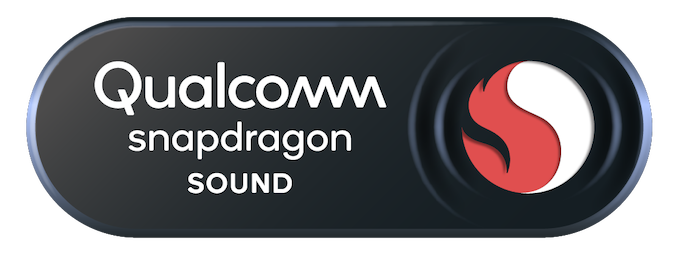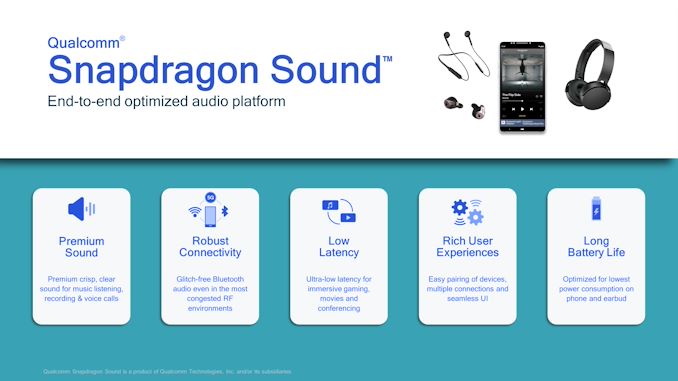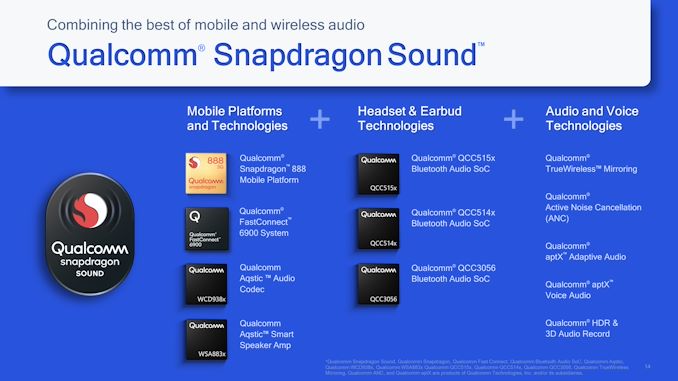Qualcomm Announces "Snapdragon Sound" Initiative
by Andrei Frumusanu on March 4, 2021 11:00 AM EST- Posted in
- Mobile
- Audio
- Qualcomm
- Smartphones

Today Qualcomm is announcing the new “Snapdragon Sound” branding initiative, essentially an umbrella term that covers the company’s various audio related hardware and software products, promising improved end-to-end interoperability for a better audio experience.
Qualcomm’s initiative is rather vague, but it appears to be to be focused on a certification program that ensures correctly engineered software stacks between a phone’s audio subsystem and the listening device. Qualcomm here particularly looks to focus on wireless audio technologies with greater audio fidelity, most of the technologies surrounding Qualcomm’s proprietary aptX codec and its derivatives. At least one concrete example of an optimised Snapdragon Sound system is Bluetooth audio latency, which would reach down to 89ms in the company’s example.
On the hardware side of things, mobile platforms obviously cover Qualcomm’s Aqstic audio codec chips as well as speaker amplifiers, but extends the umbrella out to the company’s Bluetooth audio SoCs which are popular amongst wireless headphone manufacturers.
It’s not clear if the end-to-end optimisations are solely limited to Qualcomm hardware products, or if third-party audio hardware solutions will also gain benefit of the optimised audio stack.
Qualcomm states that the first devices supporting Snapdragon Sound optimisations are expected to be available later this year.












41 Comments
View All Comments
mode_13h - Friday, March 5, 2021 - link
I use LDAC at 900 kbps all day, every day, and still get > 1 day of charge out of my year-old Sony WH-1000XM3 headphones.As for headphone jack being equivalent, I like that I don't have to carry my phone with me, literally everywhere. It means I can go back to wearing shirts without pockets.
ZolaIII - Friday, March 5, 2021 - link
It's milion pluses for the hedaphone jack after I sow audio measurement for those. But thers something in between for me like tiny DAP that I can control from the phone over BT which have WiFi and BT and of course hedaphones plugged in. Guess what means no T-shirt without pockets for me.mode_13h - Friday, March 5, 2021 - link
Another thing about wired headphones I don't miss is the cord getting snagged on door knobs, drawer handles, corners of counter tops, and pretty much everything else conceivable! Also, cord noise from it bumping and rubbing against my clothes. The only time I still use corded headphones is when I'm sitting at my desk (where I have a hi fi rig hooked up to my PC via toslink and play FLAC files).The stuff I listen to on my wireless headphones is either news or (compressed) streaming music. And I'm usually doing chores or meal prep, so I don't even care if it's not bit-perfect. The bigger quality issue is just the lower noise floor from noise cancelling, which also saves my hearing by letting me listen at lower levels.
Silver5urfer - Friday, March 5, 2021 - link
Oh yeah, sure. Lol enjoying inferior trash audio is unfortunately not my cup of tea when the phone costs $1000+, I also have a HiFi DAC AMP with Stereo Monitors plus a pair of Senn cans but sadly I cannot take them everywhere when I'm moving so I have an LG phone with Hi Fi DAC and all my FLAC and DSD and DTS movies everything on the go with an IEM with Hybrid Drivers.Well I can also use the BT headset whenever I want. More power and more choice and no compromise. But to each their own, many pay for streaming inferior compressed music which is garbage tier for me.
mode_13h - Friday, March 5, 2021 - link
I stream music in order to find new stuff to buy.And I also have a LG phone with a Hi-fi Quad DAC. But I paid < $400 for it. You can save a lot of money, if you wait for deals near the end of a phone's product cycle.
ZolaIII - Friday, March 5, 2021 - link
He is referring to modern flagships this day's with out either hedaphone jack or deacent DAC. At least I understand it like that. There are flask alike Amp's and even USB dongles which can drive 300 Ohm can's but seriously leave hard to drive desktop gear where it belongs (at home).JoeDuarte - Monday, March 8, 2021 - link
I don't understand your point on bitrates over 900 kbps. That's a huge bitrate, enough for lossless audio compression. Raw uncompressed CD quality is 1,411 kbps, so FLAC lossless should be between 700 and 900 kbps for most content. Where is the decompression happening? Before the headphones or by the headphones?ZolaIII - Monday, March 8, 2021 - link
Yup for 44100 Hz 16 bit signal however LDAC on 990 KB is 96KHz 24 bit. Arguably in top implementation with good DAC LDAC tops around 100 dB SINAD (which is more than 96 on 44100/16 signal) but however there are some obvious changes to original signal as it's losy low complexity codec as all of them are. You won't ever need more than 44100 Hz 24 bit (eventually for the compatibility reasons 48000) signal to transport as that corresponding to 150 dB SINAD and best DAC's of today only reach 120~123 dB (best mesured desktop one's). If you like to upsampling for what ever reason any DAC including 1$ one's today can do that to much higher sampling rate (can be useful to drive noise to ultra sonic range or when EQ-ing).As always path is encoder - decoder (to PCM) - DAC - analog reciver (hedaphone driver).
Today there really is no reason to insist on lo complexity codec nor to put money into the pockets of people who sell you a snake oil. Opus should be a next step in BT audio.
JoeDuarte - Tuesday, March 9, 2021 - link
Interesting. I read reports that people don't notice 24-bit over 16, and as you said a sampling rate beyond 44,100 Hz doesn't seem to have any benefit. Do you think 24-bit is beneficial?Something I've wondered about is why we don't have some sort of metadata augmentation for music tracks that could significantly improve the sound quality of lossily compressed files. The core insight is that almost all of this music is known in advance because it's out there as released music. We're compressing and decompressing it as though we don't know what it is – the encoder is essentially naive to what it is, as is the decoder. But we *do* know what it is. We know it's Lady Gaga's "Born This Way" or whatever. Since we know what it is, it seems like we should be able to analyze it thoroughly, including how MP3, AAC, and Vorbis encoders are treating it. Then distribute some sort of small augmentation file to help the listener's decoder optimize the output.
mode_13h - Wednesday, March 10, 2021 - link
> I read reports that people don't notice 24-bit over 16The argument I see for > 16-bit is things like digital volume control and Eq. If your 16-bit data is perfectly recorded and mastered, and played back in a good DAC at the right volume level, then I accept that ordinary listeners probably couldn't discern any more resolution.
> Something I've wondered about is why we don't have some sort of metadata augmentation for music tracks that could significantly improve the sound quality of lossily compressed files.
Sort of like how MP3 supports volume-normalization, maybe the dynamics of the music could be analyzed to select a more favorable set of compression parameters. That's how I'd do it. If we're talking about bluetooth, it needs to be error-tolerant, however. So, you can't have some piece of metadata that's required to decode the rest of the song and only gets transmitted at the beginning. You could look at the pre-emphasis flag as a simplistic example of that.